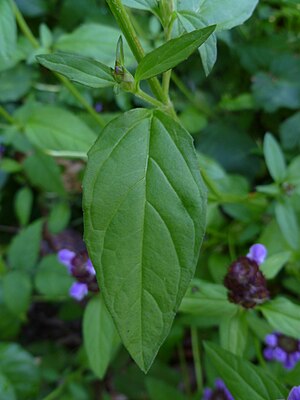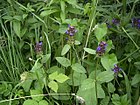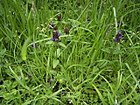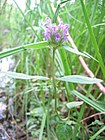Note: This is a project under development. The articles on this wiki are just being initiated and broadly incomplete. You can Help creating new pages.
Difference between revisions of "Prunella vulgaris - Self heal"
(→Mode of Propagation) |
|||
| Line 1: | Line 1: | ||
[[File:Common self-heal (Prunella vulgaris) -- leaf.JPG|thumb|right|''Prunella vulgaris'', ''self-heal'']] | [[File:Common self-heal (Prunella vulgaris) -- leaf.JPG|thumb|right|''Prunella vulgaris'', ''self-heal'']] | ||
| − | |||
'''Prunella vulgaris''' is an herbaceous plant in the genus Prunella. | '''Prunella vulgaris''' is an herbaceous plant in the genus Prunella. | ||
==Uses== | ==Uses== | ||
| − | {{Uses|High blood pressure}}, {{Uses|Fevers}}, {{Uses| | + | {{Uses|High blood pressure}}, {{Uses|Fevers}}, {{Uses|Weaknesses}}, {{Uses|Hemorrhoids}}, {{Uses|Vaginal pain}}, {{Uses|Conjunctivitis.}}, {{Uses|Sore throats}}, {{Uses|Diarrhea}}, {{Uses|Sore throats}}, {{Uses|Eczema }}, {{Uses|Psoriasis}}. |
==Parts Used== | ==Parts Used== | ||
Revision as of 12:41, 18 January 2019
Prunella vulgaris is an herbaceous plant in the genus Prunella.
Contents
- 1 Uses
- 2 Parts Used
- 3 Chemical Composition
- 4 Common names
- 5 Properties
- 6 Habit
- 7 Identification
- 8 List of Ayurvedic medicine in which the herb is used
- 9 Where to get the saplings
- 10 Mode of Propagation
- 11 How to plant/cultivate
- 12 Commonly seen growing in areas
- 13 Photo Gallery
- 14 References
- 15 External Links
Uses
High blood pressure, Fevers, Weaknesses, Hemorrhoids, Vaginal pain, Conjunctivitis., Sore throats, Diarrhea, Sore throats, Eczema , Psoriasis.
Parts Used
Chemical Composition
Contains volatile oils, flavonoids, apigenin, luteolin, quercetin, kaempferol, tiliroside, triterpene glycosides including euscapic acid and tormentic acid, phenolic acids, and 3%–21% tannins[1]
Common names
| Language | Common name |
|---|---|
| Kannada | |
| Hindi | |
| Malayalam | |
| Tamil | |
| Telugu | |
| Marathi | NA |
| Gujarathi | NA |
| Punjabi | NA |
| Kashmiri | NA |
| Sanskrit | |
| English | Herbaceous plant |
Properties
Reference: Dravya - Substance, Rasa - Taste, Guna - Qualities, Veerya - Potency, Vipaka - Post-digesion effect, Karma - Pharmacological activity, Prabhava - Therepeutics.
Dravya
Rasa
Tikta (Bitter), Kashaya (Astringent)
Guna
Laghu (Light), Ruksha (Dry), Tikshna (Sharp)
Veerya
Ushna (Hot)
Vipaka
Katu (Pungent)
Karma
Kapha, Vata
Prabhava
Habit
Identification
Leaf
| Kind | Shape | Feature |
|---|---|---|
| Simple | lance | The leaves are lance-shaped, with serrated edges and reddish tips, measuring from 5 to 8 cm. long by about 2.5 cm. wide |
Flower
| Type | Size | Color and composition | Stamen | More information |
|---|---|---|---|---|
| Unisexual | 2-4cm long | Yellow | 5 | The flowers are tubular in shape, and the upper lip forms a purplish hood, while the lower lip has 3 lobes and is white in color |
Fruit
| Type | Size | Mass | Appearance | Seeds | More information |
|---|---|---|---|---|---|
| General | 7–10 mm | clearly grooved lengthwise, Lowest hooked hairs aligned towards crown | many | {{{6}}} |
Other features
List of Ayurvedic medicine in which the herb is used
- Vishatinduka Taila as root juice extract
Where to get the saplings
Mode of Propagation
How to plant/cultivate
Easy to grow plant for any soil in full sun or partial shade. May be considered invasive. Attract bees and other beneficial insects. Good ground cover[3]
Commonly seen growing in areas
Terrains, Including grassland, Woodland edges, Roadsides, Wastelands.
Photo Gallery
References
External Links
- Ayurvedic Herbs known to be helpful to treat High blood pressure
- Ayurvedic Herbs known to be helpful to treat Fevers
- Ayurvedic Herbs known to be helpful to treat Weaknesses
- Ayurvedic Herbs known to be helpful to treat Hemorrhoids
- Ayurvedic Herbs known to be helpful to treat Vaginal pain
- Ayurvedic Herbs known to be helpful to treat Conjunctivitis.
- Ayurvedic Herbs known to be helpful to treat Sore throats
- Ayurvedic Herbs known to be helpful to treat Diarrhea
- Ayurvedic Herbs known to be helpful to treat Eczema
- Ayurvedic Herbs known to be helpful to treat Psoriasis
- Herbs with Whole herb used in medicine
- Herbs with common name in English
- Habit - Herb
- Index of Plants which can be propagated by Seeds
- Herbs that are commonly seen in the region of Terrains
- Herbs that are commonly seen in the region of Including grassland
- Herbs that are commonly seen in the region of Woodland edges
- Herbs that are commonly seen in the region of Roadsides
- Herbs that are commonly seen in the region of Wastelands
- Herbs










